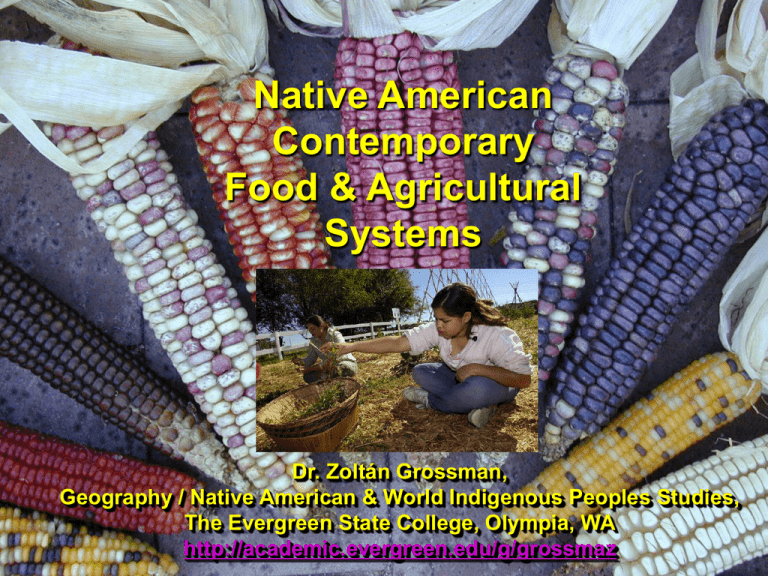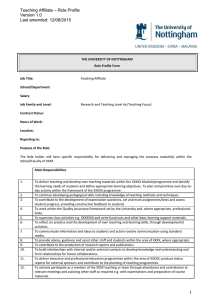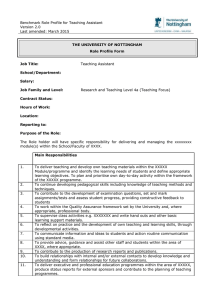Native American Contemporary Food & Agricultural Systems
advertisement

Native American Contemporary Food & Agricultural Systems Dr. Zoltán Grossman, Geography / Native American & World Indigenous Peoples Studies, The Evergreen State College, Olympia, WA http://academic.evergreen.edu/g/grossmaz Across Native America, a new "food movement" is growing and distributing traditional indigenous foods, in order to reintroduce them to tribal members' diets, and in the process strengthen tribal cultures, improve tribal members' health and nutrition, and develop sustainable agricultural economies on Native lands. Liliget Feast House, Vancouver Xxxx Xxxx Xxxxx xxxxx National Museum of the American Indian Xxxx Xxxx Xxxxx xxxxx xxxxx Xxxx Xxxx Xxxxx xxxxx xxxxx Xxxx Xxxx Xxxxx xxxxx xxxxx Xxxx Xxxx Xxxxx xxxxx Gary Paul Nabhan “Cupping my two hands together, I can hold a single seed of each plant that grows on the acres of desert land…. When pooled together, these microcosms of life…contain more Information than is contained in The Library of Congress…” (Nabhan, Prologue) Xxxx Xxxx Xxxxx xxxxx Winona LaDuke “Growing food is the centerpiece of the Indigenous relationship to birth and the land. By planting and nurturing seeds, Native peoples call forth and honor life through an intricate ceremonial cycle at the heart of Indigenous cultures.” Food allocation as a weapon Mr. Andrew Myrick, a trader… had refused some hungry Indians credit a short time before when they asked him for some provisions. He said to them: “Go and eat grass.” Now he was lying on the ground dead, with his mouth stuffed full of grass, and the Indians were saying tauntingly: “Myrick is eating grass himself.” --Jerome Big Eagle, or Wamditanka Santee Dakota Uprising, MN 1862 Navajo livestock reduction, 1930s Drought diminished rangeland, 1933-35 Government reduces 16-27% of Navajo livestock; Jail herders or confiscate herd if not comply From 1930 to 1952, Navajos had lost 80% of their per capita holdings Navajo churro sheep Native American Farm Owners Part owners Full owners 25,000 20,000 15,000 10,000 22,000 14,300 1,700 5,000 4,700 0 Nabhan, 62 1910 1950 1982 Native American Farming, 20th century Encroachment by non-Indians on Native farmland/range Non-Indian lease holdings on Native land KeepsEagle v. Veneman: Native American farmers suing USDA for discrimination in access to operating loans Commodity Foods Food assistance (commodity) programs, 1930s; Run by states, then USDA with tribes Introduced sugar, white flour, lard, cheese, domestic meats into diet and culture Refined foods nearly half of food energy Created obesity, diabetes, heart disease, hypertension (GAO 1989) Diabetes Epidemic Tribal sustainable agriculture is reintroducing traditional foods to counteract the current tribal epidemic of diabetes, and the poor nutrition resulting from the U.S. white flour and sugar diet. 1 out of 8 Native Americans have diabetes—2X the rate of the rest of the U.S. population. QuickTime™ and a TIFF (Uncompressed) decompressor are needed to see this picture. Rare before 1940s, now 2nd most common diagnosis for Native hospital patients Diabetes Epidemic Indian Health Service (IHS) office in Bemidji, Minnesota reported in 1995 that the age adjusted diabetes mortality rate was 4X higher for the Native community than that of the general population. Risk of leg amputation 15-40X more if have diabetes (54,000 people a year) Diabetes is “widely recognized that the replacement of indigenous foods with a diet composed primarily of modern refined foods is the enterpiece of the (diabetes) problem.” Journal of American Diabetic Association “Thrifty Gene” Basal Metabolic Rate (BMR) has set point, determines rate of processing and storing calories Thrifty gene has a lower set point, allowing bodies to store more food as fat (advantage in winter pre-industrial society; disadvantage with high-fat/ carb commod foods) Tied to seasonal wild foods (set point lower in fall; higher in spring). Controversial: Theory can be misused! Responding to diabetes Not inevitable because of gene; focus on lifestyle, school lunch and elder food programs Fitness programs (wellness centers); Food programs in field to increase exercise Gila River Study, AZ A study in 1991 looked at traditional foods and Pima Indians on the Gila River Reservation. In the study, 12 tribal members who were not diabetic volunteered to eat the “traditional diet” of hominy, beans, acorns, and other foods for two weeks, followed by the “modern diet” for two weeks. Blood sugar and other values were charted during each diet period. The results were conclusive: “the traditional high fibercomplex carbohydrate and low fat diet resulted in a slower release and uptake of sugars from the intestines” while the modern diet “soon produced higher blood sugar levels.” (Hanson, 22) Native Agriculture & Food Systems Initiative • Providing financial and technical support to projects that seek to address the agriculture and food sectors in Native communities. • Undertaking research projects that build the knowledge and understanding of Native agriculture and food systems issues, and inform Native communities about innovative ideas and best practices. • Participating in policy forums that work to develop legislative and regulatory initiatives in support of Native agriculture and food systems. • Building and supporting a regional and national network of Native food sector and related organizations. • Developing training materials and other resources to assist communities in identifying the resources and strategies necessary to develop sustainable Native agriculture and food systems. www.firstnations.org/default2.asp?active_page_id=160 Native Food and Agriculture Resource Manual http://www.firstnations.org/ Publications/FARM_final1.pdf Native Food Summits Aims are to increase tribal food security through community food system projects, and development of agricultural business enterprises. The Summits built connections around culture, food, diet and health, and showcased successful food system projects in Indian Country. Albuquerque 2002, Milwaukee 2004, Santa Fe 2007 Traditional Native American Farmers Association * To reverse the decline in traditional, familyscale farming among the community by developing educational programs that demonstrate sustainable agriculture. * To demonstrate and train communities and youth in a holistic approach to sustainable agriculture based upon community ethics and traditions. * To help the community access heirloom/ traditional seeds * To educate the community on traditional seed saving and the GE,GMO threat to our traditional seed heritage. * Identify local resources for agriculture, compost materials, local plants, local herbs, water supplies, local farmers, local markets, etc. * Revive and restore a sustainable economic base through organic agriculture for our youth Traditional Native American Farmers Association * Corn processing for home use (traditional foods/nutrition) * Community seed “library” workshops (methods of storing and growing for seed) * Seed distribution (free seed and information about seed) * Home gardening workshops (garden design, composting, organic methods, irrigation, drip irrigation, etc.) * Traditional Ag/Permaculture Course (12 days on sustainable community design) * Youth in agriculture (developing youth garden projects) * Other workshops (marketing traditional •crops, packaging, value added crops, herbs) Intertribal Agriculture Council http://www.indianaglink.com * To provide a unified effort to promote change in Indian Agriculture for the benefit of Indian People. * Promote the Indian use of Indian Resources for the benefit of Indian People * Contracts and cooperative agreements with federal agencies. Indigenous People's Council on Biocolonialism Xxxxx xxxxx http://www.ipcb.org Center for World Indigenous Studies http://www.cwis.org White Earth Land Recovery Project http://www.nativeharvest.org Native Seeds/SEARCH http://www.nativeseeds.org “From the traditional perspective, these seeds encompass more than just characteristics. They are sacred heirlooms, which are ‘witnesses to the past.’ These seeds hold cultural value and cultural memory that is a vital part of traditional culture and history. A cultural community that persists in its farming tradition does not simply conserve indigenous seed stock because of economic justifications, the seeds themselves become symbols, reflections of the people’s own spiritual and aesthetic identity, and of the land that shaped them.” -- Rowan White, Mohawk farmer and scholar Desert crop adaptation (Nabhan) Hopi maize adapted to sand, deep roots to seek moisture, clumping for protection; grows better /faster than midwest Bantam Heterogeneity in variety, not as vulnerable to pests and diseases Weedy Teosinte maize (Chihuahua) has hardiness in cold, drought; Smaller but grows larger with cultivation Wild crop advantages (Nabhan) Wild varieties have diverse and sophisticated adaptation systems Mixture of wild and cultivated at untended field margins; Wild varieties improve cultivated varieties (e.g., hotter chiles) Wild beans harder (but not smaller) than cultivated varieties; Have to cultivate to prevent spoilage Wild crop advantages (Nabhan) Heirloom varieties in marginal lands have better survival and quality Cultural persistence from shared symbols and values Tohono O’odham Community Action, AZ works with Native Seeds/SEARCH http://www.tocaonline.org Seed Saving Cora Baker, a Potawatomi Native American from Wisconsin, spent a lifetime collecting heirloom seeds; some of her stock are believed to link back to plants that grew more than 800 years ago. “I had prayed and prayed that someone would take this gardening up again,” she wrote, with the help of her great-granddaughter, shortly before her death in 2000 at the age of 94. “I feel that the Great Creator has answered my humble prayers.” Seed Saving The answer came in the form of Dream of Wild Health, a gardenbased education program in St. Paul, Minnesota, the group to whom Baker sent her collection. Now, Baker’s life savings of seeds are flourishing into black turtle beans, Mandan blue flint corn, colorful Arikara squash and Potawatomi lima beans. “We’re growing things we’ve never seen,” says Sally Auger, executive director of the project. “It’s an awesome responsibility to carry this on.” --Sheila Mulrooney Eldred (EatingWell, June/July 2006) Dream of Wild Health Farm, Hugo MN Salt River Community, southern Arizona (Pima-Maricopa) Only 4 out of 60 families use native seeds Sucker fish (o’omuni) virtually disappeared from rivers 5-acre test of 6 commercial vegetable crops, 26 desert crops; Bugs overwhelmed commercial crops without touching desert crops Salt River Pimas & Maricopas The Onk Akimel Authum (Pima) and the Piipash (Maricopa) share a 53,600-acre reservation They have one of the richest nutritional histories with their cultivated corn, beans, and squash, and their wild foods. Pimas have to learn dry farming techniques from the Tohono O’odham because they no longer have a river and can no longer farm using their traditional ways. “We always had water; we didn’t have to depend on the rain. We always had food. Historically, we had communal garden plots along the floodplain of the river, using the fine alluvial silt as fertilizer.”--Jacob Butler Salt River Pimas & Maricopas Pimas and Maricopas are now surrounded by the sprawling suburbs of Phoenix; 12,000 acres of reservation held by non-Natives World’s leader in diabetes; they have more people with diabetes Per capita than any other community in the world. One of the largest groups affected by the increase in diabetes is youth Salt River Pimas & Maricopas Community course on modern methods of sustainable housing, energy, food production, and wild plant harvesting. Over 15 gardens on the reservation, including a large community garden, 10 home site gardens, an elders’ garden, a garden at the Juvenile Detention Center and gardens at the elementary schools. “We want to teach the kids that they can grow these foods to feed themselves and have their own enterprise at the same time. When we first introduced this to the kids in the schools, they asked, ‘Why should we do this if we can just go to the grocery store?’ We are teaching kids an introduction to growing and their heritage. A lot of people don’t like to eat these foods, so we have to reintroduce them…” --Jacob Butler Jacob Butler “This was a way for me to reconnect with my culture. There was no other way to learn about my people. So I started looking at what they did on a daily basis: grow, gather, and hunt. Now that I’m learning these things, more traditional people are coming up and offering their knowledge to me, because they know that I’m Authum and have something to offer them and the community.” Pima word for “wildness” resembles words for “wholeness,” “health” Jacob Butler “The kids are picking it up and going home and asking their parents about the seeds, foods, and traditions. We asked them to go home and find the traditional names, so they sit down with their parents talking about seeds. For some of these kids, it’s the longest they’ve ever talked to their parents, so we’re creating family communication. We’re bringing back the traditional knowledge, and then kids want to put a garden at their house, so we’re bringing back the foods too.” Gitiganing Ojibwe for “Place of the gardens,” Bad River Reservation, northern Wisconsin “The concept is that food is medicine. If we’re going to win, we have got to change our whole lifestyle. But you can’t eat what you don’t have. So it’s a long-term change.” --Luis Salas Bad River Reservation, WI Gitiganing Historic site of Spring planting of corn, beans, squash, tobacco, and sunflowers. 1 out of 8 tribal members has diabetes and one out of four dies from heart disease. Gitiganing Restoration Project strives to combat diabetes by re-introducing highquality traditional foods Into community diet, 1999 Gitiganing “For me it’s spiritual and it’s survival.”—Becky Lemieux Project has helped 100 families start gardens at their home, planted over 400 fruit trees, created several community gardens, started an heirloom seed bank, and brought gardening and nutrition activities to Bad River youth. Pumpkin garden for Head Start children/families, planting heirloom seeds from Omaha Tribe, 2002 Gitiganing Youth Garden Project Five youths become leaders working on the whole gardening cycle, from design to planting, care, harvest, and seed saving, with elder mentor Five new community gardens: •Medicinal Teaching Garden in the shape of a turtle •Heritage Garden containing traditional Ojibwe plants •Diabetes Garden with traditional and non-traditional foods •Three Sisters gardens, one for the Bad River Daycare and one for Powwow Grounds. xxxxx Xxxx Xxxx Xxxxx xxxxx xxxxx NATION ONEIDA WHITE FLINT CORN "Corn is the kernel of the culture." --Dr. Carol Cornelius, Oneida Cultural Heritage Department manager Photos and text by Michele Shaw and Zoltán Grossman, University of Wisconsin-Eau Claire, 2004 xxxxx The Oneida people have not only grown the white flint variety of corn since before European contact, but have relied on it as their Tsyunhehkwa ("Life Sustenance"). The Oneida brought the white corn with them in their migration xxxxx from New York State in the 1820s, and replanted it along with their culture in Wisconsin soil. Traditionally, white flint corn was grown by many Oneida families, and was seen as central to the survival of the tribe and the community. Maize was part of an integrated agricultural system called the xxxxx "Three Sisters," growing beans, and squash together in the same mound, in a practice today called "intertillage.” Xxxx Xxxx Xxxxx xxxxx xxxxx The tall corn provided a structure for the beans to grow upon. The beans, along with the nutrients they provided, fixed the nitrogen in the soil, making more nitrogen available for the corn to consume. Iroquois farmers grew 60 varieties of beans in the early 1900s. The squash spread out into the spaces xxxxx between the mounds, and covered the ground to suppress the weeds and keep moisture in the soil. It provides shade and covers the soil, preventing small animals from feeding on the corn. Three Sisters The Oneida still grow the Three Sisters today, using both traditional and modern methods, as one example of a national Indigenous trend to reintroduce Native foods back into tribal food systems as healthy alternatives. The corn supplies carbohydrates, beans contribute protein, and squash gives Vitamin A. Three Sisters Diohe’ko (”These Which Sustain Us”) “The Three Sisters are our medicine. When we eat them regularly, we stay in good health. Our bodies are in balance. Our spirit is renewed since we are fulfilling our Creator’s instructions. As we drift to western or foreign diets we are no longer in balance and disease develops.” – Brenda LaFrance, Mohawk Planting a Three Sisters Garden 1. Once the danger of frost has passed, prepare the garden site by piling soil into small hills about a foot high and about 20 inches across. The centers of your mounds should be about four feet apart and should have flattened tops. 2. In the center of each mound, plant five or six corn kernels in a small circle. These seeds should be soaked overnight before planting. Each mound will later be thinned to three or four seedlings to prevent overcrowding. 3. When the corn seedlings have grown a bit (5-6 inches), plant seven or eight pole beans in a circle about six inches away from the corn kernels. 4. A week later, at the edge of the mound a foot away from the beans, plant 7-8 squash or pumpkin seeds. 5. When the plants begin to grow, you will need to weed out all but a few of the strongest of the corn plants from each mound. Keep the healthiest of the bean & squash plants; weed out the weaker ones. 6. Be sure that the beans are supported by cornstalks and that they wrap around the corn. Add high-nitrogen fertilizer such as aged manure or fish emulsion on the soil surface near each corn plant. 7. The squash will spread out between the mounds. Be sure that they stay on the edge so as not to crowd out the beans and corn. Once the fruits begin to show, add manure or compost to add nutrients and help the plant to grow. xxxxx It is no short of a miracle that white flint corn is still grown today in Wisconsin, given the formidable historical obstacles presented to the Oneida. xxxxx Within their village palisades, the Iroquois grew white corn in complex agricultural beds. xxxxx Xxxx Xxxx Xxxxx xxxxx xxxxx Xxxx Xxxx Xxxxx xxxxx xxxxx The Oneida, or On^yote?a.ka ("People of the Standing Stone") are originally from New York State, where they were one nation within the Six Nations Iroquois Confederacy, or Haudenosaunee. xxxxx After the Revolutionary War, American land settlement pressured the Oneida to search for more secure land to the west. In 1823, some Oneida migrated to land they purchased west of Green Bay, where their 65,430-acre reservation was established in 1838. During the past two centuries of Migration, Allotment, Depression, Relocation and pollution, the white flint corn has remained with the Oneida people, grown by families on their farms and garden plots. Oneida Reservation In 1823, some Oneida migrated to land they purchased west of Green Bay, where their 65,430acre reservation was established in 1838. Oneida agreement for Wisconsin land in Menominee territory, 1838 Oneida Reservation The Indian Allotment Act of 1887 divided Native reservations into privately held parcels, which left the lands vulnerable to confiscations, foreclosures, and fraudulent acquisitions by non-Indians. The fertile lands of the Oneida Reservation, adjacent to a growing urban area, were particularly vulnerable. The tribally held lands dwindled to only a few hundred acres by 1924. The 1934 Indian Reorganization Act established a federally recognized xxxxx tribal government and stopped the loss of tribal lands. In 1937, 1,270 acres of land were placed in trust for the Oneida, yet during the Depression (and through the 1950s), farming jobs were scarce. Tribal members were forced to rely on a commodities diet of white flour, sugar, and lard that led to a high rate of diabetes. xxxxx The federal government's next attempt to assimilate Native Americans was to relocate them to cities, often far from home. It was only in the 1970s-1980s that the Oneida and other tribes began to exercise some self-determination over their education, health care, community development, and the sovereign regulation of their own lands. Oneida Reservation After Congress in 1988 recognized tribal gaming rights (in states that already practiced gaming), the Oneida built a successful casino that jumpstarted their economic and cultural programs. The tribal land base within the reservation increased to about 4,600 acres by the 1990s, and the tribe built a new school. Yet urban sprawl and the pollution from Fox River Valley paper mills still encroached on Oneida farmland. xxxxx As part of the new resurgence of economic and cultural development, the Oneida Nation of Wisconsin has established a new farm dedicated to production, processing and distribution of white flint corn and other traditional products. xxxxx The Oneida farm is called Tsyunhehkwa ("Life Sustenance," or more literally” "It provides life for us"). The Oneida name is pronounced Joon hey-kwa. The Tsyunhehkwa program is part of the Oneida xxxxx Community Integrated Food Systems (OCIFS), and consists of three divisions, covering Production, Processing, Distribution. Xxxx Xxxx Xxxxx xxxxx Production Division Agricultural and Community Services Shakoh^ta?slu.níhe? ("He prepares the fields for them"). Education and outreach xxxxx services, garden workshops and a traditional husking bee, a solar greenhouse, seed bank and seed saving circle. Xxxx Xxxx Xxxxx xxxxx The Production Division offers organic vegetables and berries, xxxxx community seeds and plants, Heirloom Iroquoian white flint corn, custom-raised grass-fed beef, pastured poultry and free-range eggs. Oneida families and youth are involved in every aspect xxxxx of white flint corn production. Husking Bee Anyone may participate in the preparation of the seed, the green corn harvest, and the Husking Bee. The husking bee, held after the Fall harvest in October, is critical to the selection of seed for the next year's crop. Xxxx Xxxx Xxxxx xxxxx xxxxx After husking, the white flint corn is braided The corn is then xxxxx hung and dried Xxxx Xxxx Xxxxx xxxxx xxxxx Throughout the year, volunteers shell the corn by hand, and store the kernels in bins. Processing Division Community Cannery, or Tsi?tkutekhwa.y^hé ("Where they put the food away"). Processing Division The Division includes food canning and Indigenous food workshops, and food preservation assistance. The white corn is cooked with hardwood ash to break down the hard outer shell, and is then canned or dehydrated. The corn, canned either with or without meat, is traditionally used to make nutritious corn soup. The dehydrated corn is either sold or ground to make corn flour. Community Cannery Cannery products include canned white corn soup, corn flour, dehydrated corn, and Kan^stóhale (traditional corn bread). Kan^stóhale has a short shelf life, so it is baked about 4 times a week. The Community Cannery is a significant attribute in Oneida food systems not only by processing white flint corn, but by offering the facility to community members to do their home garden canning, and buy common Spring starter plants Distribution Division Retail and Community Services, or Lutunhetsla?nikulale? ("They look after all living things"). Offers "Herbal Harmony" tea blends and bulk herbs, traditional medicinal herbs, white corn soup, raw and dehydrated white corn, corn flour and bread, wild rice, and other items. It provides workshops and materials on preventative health and traditional foods or herbs. Tsyunhehkwa has reintroduced organically grown foods to the Oneida xxxxx Nation to ensure a healthier diet and lifestyle for tribal members, who had been dependent on unhealthy commodity foods. Xxxx Xxxx Xxxxx xxxxx By doing so, it also seeks to educate tribal members and the xxxxx wider community about Native traditional food systems, rooted in the ancient past, and updated to the modern age with sustainable technologies (such as a solar-heated greenhouse). Most importantly, the traditional farm also reintroduces a cycle xxxxx of cooperation within the community, with Oneida and their neighbors of all generations working together to harvest, process and distribute the crops. The white flint corn and other food crops provide a cultural connection to tribal ancestors, and a reason to rebuild a sense of community and nationhood. Study Questions • Discuss six motivations for the contemporary Native American food movement, addressing the cultural, economic, political, health, social, and ecological priorities of the movement, and how each of these values can be seen as distinct from the mainstream “organic” movement. • How do Native peoples in the Northern Plains (such as the Lakota or Western Sioux) view their identity and historical experiences as parallel to the bison? • Describe the cultural and ecological aspects of the “Three Sisters” to the Haudenosaunee (Iroquois). • Discuss food as cultural symbology, comparing at least two historical examples, such as pomegrantes, bison, white flint corn, or the Three Sisters.



